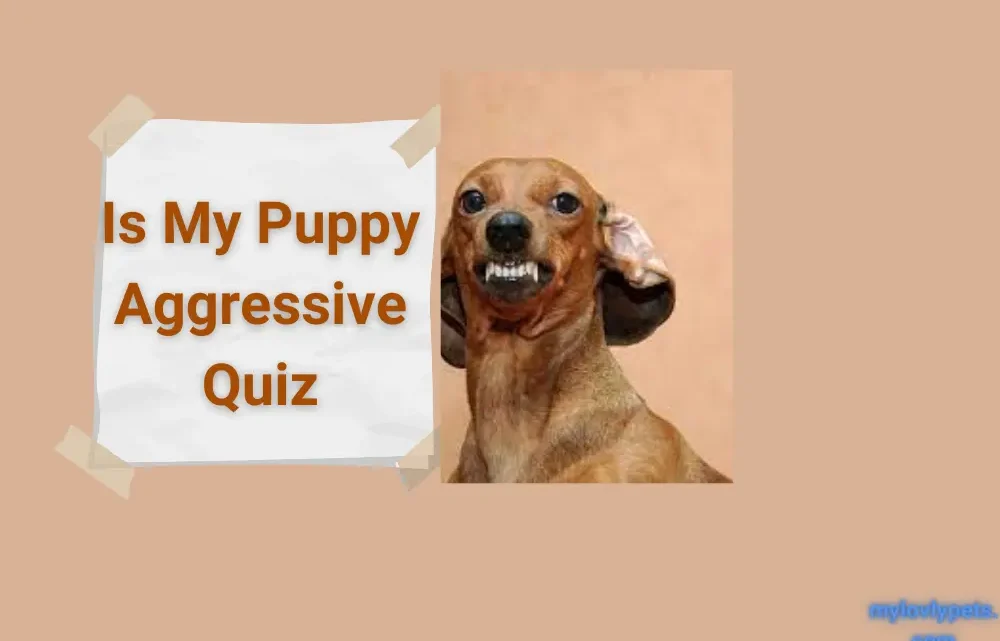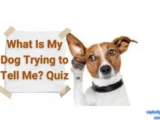
Is My Puppy Aggressive? Take This Quiz to Find Out!
Bringing a new puppy into your home is an exciting yet challenging experience. As responsible pet owners, it’s crucial to understand your puppy’s behavior, especially when it comes to signs of aggression. To provide a more comprehensive assessment, we’ve expanded our quiz to 30 questions. Is my puppy aggressive? Take this comprehensive quiz to find out! This quiz aims to help you gain a deeper understanding of your puppy’s behavior and whether any signs of aggression may need attention.
Is My Puppy Aggressive Quiz
Playtime Behavior:
- a) Plays gently and enjoys interacting with people and other animals.
- b) Sometimes gets a bit rough, but stops when told to.
- c) Frequently growls, snaps, or bites aggressively during play.
- d) Shows signs of possessiveness over toys and doesn’t like sharing.
Food and Resource Guarding:
- a) Allows you to approach and take away food or toys without any issues.
- b) Shows some reluctance but ultimately allows you to take away items.
- c) Displays signs of aggression when someone tries to take away food or toys.
- d) Guarding behavior extends to other resources like sleeping areas or favorite spots.
Meeting New People:
- a) Excited and friendly, wagging tail and approaching with curiosity.
- b) A bit reserved or cautious at first but warms up after a while.
- c) Shows signs of fear or aggression, such as barking, growling, or backing away.
- d) Displays aggressive behavior specifically towards certain types of people (e.g., children, strangers).
Handling and Grooming:
- a) Enjoys being touched and groomed, showing no signs of discomfort.
- b) Tolerates handling but may resist in certain situations.
- c) Resists handling, growls, or snaps when touched or groomed.
- d) Displays aggression during routine care activities, like nail trimming or ear cleaning.
Reaction to Corrective Measures:
- a) Responds well to gentle corrections and adjusts behavior accordingly.
- b) Takes corrections into consideration but may need consistent reminders.
- c) Reacts aggressively or defiantly to corrections, displaying signs of anger or frustration.
- d) Becomes more aggressive when corrections are applied.
Reactivity to Environmental Stimuli:
- a) Remains calm and composed in various environments and situations.
- b) May get a bit anxious or excited in new situations but generally adjusts well.
- c) Displays signs of fear or aggression when exposed to new environments or stimuli.
- d) Reacts aggressively to specific stimuli, like other animals or loud noises.
Body Language:
- a) Exhibits relaxed body language with ears and tail in a natural position.
- b) Displays occasional signs of tension or anxiety but relaxes with reassurance.
- c) Often has a stiff body, raised hackles, or other signs of defensive aggression.
- d) Exhibits dominant or confrontational body language regularly.
Read here
| Signs of a Confident Dog/ Insecure Dog Body Language |
Playful Biting and Mouthing:
- a) Occasionally engages in gentle mouthing during play but responds to redirection.
- b) Has a tendency to mouth or bite during play but adjusts behavior with training.
- c) Frequently bites hard during play, and redirection is challenging.
- d) Bites aggressively even outside of play situations.
Response to Strangers Approaching:
- a) Welcomes strangers with curiosity and friendliness.
- b) Observes strangers cautiously but warms up after a brief introduction.
- c) Exhibits signs of fear or aggression towards strangers, even after a gradual introduction.
- d) Shows aggression towards strangers without any apparent provocation.
Territorial Behavior:
- a) Shows no signs of territorial aggression.
- b) Marks territory occasionally but responds to correction.
- c) Displays signs of territorial aggression, such as barking or growling at perceived intruders.
- d) Exhibits extreme territorial behavior, becoming aggressive even with familiar individuals.
Playgroup Behavior with Other Dogs:
- a) Plays well with other dogs, exhibiting appropriate social behavior.
- b) Occasionally engages in rough play but adjusts based on cues from other dogs.
- c) Demonstrates aggression towards other dogs during play, such as growling or snapping.
- d) Shows aggression towards other dogs even outside of play situations.
Response to Physical Touch:
- a) Enjoys being petted and cuddled without any signs of discomfort.
- b) Accepts physical touch but may signal discomfort in certain areas.
- c) Resists physical touch, growling or snapping when touched in specific areas.
- d) Displays aggression when approached physically, regardless of the area.
Read
| Is My Dog Special Needs Quiz |
Energy Levels:
- a) Maintains a balanced energy level, neither excessively hyper nor lethargic.
- b) Exhibits occasional bursts of energy but can be easily redirected.
- c) Displays consistently high energy levels and becomes agitated easily.
- d) Exhibits unpredictable and extreme energy fluctuations.
Response to Handling Paws and Ears:
- a) Allows handling of paws and ears without any resistance.
- b) Tolerates handling but may pull away or show mild discomfort.
- c) Resists handling, growls, or snaps when paws or ears are touched.
- d) Displays aggression specifically when paws or ears are touched.
Behavior During Training Sessions:
- a) Enjoys training sessions and responds positively to commands.
- b) Takes part in training but may lose focus or interest at times.
- c) Exhibits defiance or aggression during training sessions, making them challenging.
- d) Displays aggression when asked to perform certain commands.
Response to Children:
- a) Shows positive and friendly behavior towards children.
- b) Approaches children cautiously but warms up with gentle interactions.
- c) Exhibits signs of fear or aggression towards children.
- d) Displays aggression towards children without apparent provocation.
Sleeping Behavior:
- a) Sleeps soundly and peacefully without any signs of aggression.
- b) May growl or show possessiveness over sleeping areas but responds to correction.
- c) Displays aggression when approached while sleeping or resting.
- d) Guards sleeping areas aggressively and may show aggression even when approached cautiously.
Reaction to Medical Procedures:
- a) Cooperates during routine veterinary examinations and medical procedures.
- b) Requires some coaxing but generally allows medical procedures with minimal resistance.
- c) Resists and may display signs of aggression during medical procedures.
- d) Displays extreme aggression during medical procedures, requiring sedation or specialized handling.
Response to Sudden Movements or Noises:
- a) Remains calm in response to sudden movements or noises.
- b) May startle but quickly recovers with reassurance.
- c) Exhibits fear or aggression in response to sudden movements or loud noises.
- d) Reacts aggressively to any unexpected stimuli, displaying heightened sensitivity.
Attention-Seeking Behavior:
- a) Seeks attention in a playful and non-intrusive manner.
- b) Occasionally demands attention but responds well to redirection.
- c) Displays demanding or aggressive attention-seeking behavior.
- d) Exhibits aggressive behavior to get attention, even if it involves negative interactions.
Response to Various Environments:
- a) Adapts well to different environments without signs of stress.
- b) Takes time to adjust but eventually becomes comfortable in new environments.
- c) Exhibits signs of fear or aggression in unfamiliar environments.
- d) Displays aggression consistently in different environments, regardless of familiarity.
Handling by Strangers:
- a) Accepts handling by strangers without signs of aggression.
- b) Tolerates handling but may be wary of unfamiliar individuals.
- c) Exhibits signs of fear or aggression when handled by strangers.
- d) Displays aggression towards strangers, especially during attempts at handling.
Response to Other Pets:
- a) Gets along well with other pets, displaying friendly behavior.
- b) May need time to adjust but eventually coexists peacefully with other pets.
- c) Exhibits signs of fear or aggression towards other pets.
- d) Displays aggression towards other pets consistently, even outside of direct interactions.
Barking Behavior:
- a) Barks appropriately in response to stimuli but stops when prompted.
- b) Occasionally barks but can be redirected with commands.
- c) Barks excessively and aggressively, especially without apparent reason.
- d) Displays aggressive barking towards specific individuals, animals, or situations.
Response to Unfamiliar Objects:
- a) Approaches unfamiliar objects with curiosity and no signs of fear.
- b) May be cautious initially but investigates unfamiliar objects after a while.
- c) Exhibits fear or aggression towards unfamiliar objects.
- d) Reacts aggressively towards unfamiliar objects consistently.
Reaction to Physical Disturbances:
- a) Remains calm during physical disturbances (e.g., loud noises or disruptions).
- b) May startle but quickly recovers with reassurance.
- c) Exhibits signs of fear or aggression in response to physical disturbances.
- d) Reacts aggressively and unpredictably to physical disturbances.
Response to Confinement:
- a) Accepts confinement without signs of stress or aggression.
- b) May show initial reluctance but adjusts to confinement.
- c) Exhibits signs of stress or aggression when confined.
- d) Displays extreme aggression when confined, even in familiar spaces.
Excessive Chewing or Destructive Behavior:
- a) Chews on appropriate items and shows no destructive tendencies.
- b) Occasionally chews on inappropriate items but can be redirected.
- c) Engages in excessive chewing or destructive behavior, especially when frustrated.
- d) Displays aggressive behavior towards objects or people during destructive episodes.
Response to Sudden Touch:
- a) Remains calm when touched unexpectedly.
- b) May startle briefly but quickly recovers.
- c) Exhibits signs of fear or aggression in response to sudden touches.
- d) Reacts aggressively to unexpected touches consistently.
Response to Novel Experiences:
- a) Approaches novel experiences with curiosity and adaptability.
- b) Takes time to adjust but eventually becomes comfortable with new experiences.
- c) Displays signs of fear or aggression towards novel experiences.
- d) Exhibits aggression consistently when faced with new and unfamiliar situations.
Interpreting Your Results:
Mostly A’s: Your puppy displays typical and healthy behavior. It seems to be well-adjusted and comfortable in various situations.
Mostly B’s: Your puppy may show occasional signs of assertiveness or discomfort, but with proper training and socialization, these behaviors can be managed.
Mostly C’s: There may be signs of aggression in your puppy’s behavior. It’s crucial to seek guidance from a professional dog trainer or behaviorist to address these issues promptly.
Mostly D’s: Your puppy is displaying significant signs of aggression that may require immediate attention from a professional. Consultation with a certified dog behaviorist or trainer is strongly recommended for personalized guidance and intervention.


